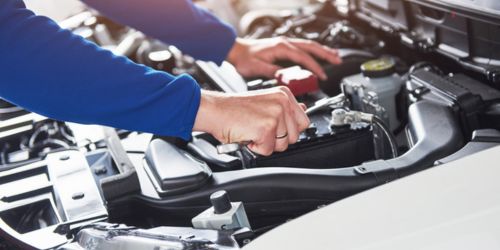Auto maintenance service is very important for a car owner. Basic service intervals for essential engine parts are outlined in the owner’s manual’s maintenance schedule section. The oil and oil filter are two of these parts. Oil is the blood of your car’s engine. When it’s time for an oil change, you should choose between synthetic and traditional oil based on your budget and the vehicle’s requirements. In this article, we explained what import auto maintenance service is all about. Enjoy the ride!
What Is Auto Maintenance?
The finest possible performance from your vehicle each and every time you take it out on the road requires regular checkups. Car performance may be maximized and future repair expenses reduced with regular auto maintenance service. Keeping up with the recommended oil changes in your owner’s manual can ensure that your vehicle’s engine remains in top condition. Towing a trailer or driving in dusty circumstances calls for more regular oil changes, and you should seriously consider upgrading to synthetic oil. The spark plugs and spark plug wires, as well as the PCV valve, should also be inspected.
Keeping your car in good shape is crucial. It’s an investment that pays off in the long run by keeping your automobile in good shape and looking good. There are a lot of issues that might arise because many people don’t know how to keep their cars in good working order.
Also, if you care about keeping your car looking good and lasting a long time, you should know that a good car cover is a must-have item. By preventing dust, filth, and debris from settling on the exterior and interior surfaces, car coverings facilitate cleaning and lessen the need for frequent washing. They also shield the interior from the sun’s harmful ultraviolet rays, which can dry up the leather, break the dashboard, and fade the paint. Additionally, car coverings shield the vehicle from precipitation, snow, and hail, all of which can harm the car’s exterior and speed up the deterioration of specific components.
The Essence of Auto Maintenance
Keeping your car in good working condition for as long as possible after purchasing it is a top priority. That’s where regular auto maintenance of your vehicle comes in. You can keep your automobile operating smoothly and save money on repairs in the long term if you service it periodically and address any issues that crop up. This also entails spending money on the car’s necessities and replacing any broken components. This will ensure that your car’s performance is optimal regardless of its make or model. Since there are two major forms of import auto maintenance; preventive and corrective, investing in high-quality Ford F-150 wheel hubs and bearings is a smart way to head off potential problems down the road.
Performing preventative auto maintenance is all about stopping issues before they start. After an issue has arisen, you should perform corrective maintenance, such as replacing a blown fuse or repairing a flat tire. Experts agree that if you stick to a preventative maintenance routine, you can save yourself the trouble and money that would otherwise be spent on problems.
The Importance Of Regular Maintenance
For several reasons, it’s crucial to keep up with your car’s routine auto maintenance. To begin with, it has the potential to enhance your vehicle’s efficiency and performance. If you keep up with routine maintenance, your car won’t have to exert as much effort to perform the same tasks as one that hasn’t. This has the potential to increase fuel efficiency and improve ride quality. Furthermore, major problems can be avoided by routine maintenance, allowing your vehicle to last longer.
Preventing the need for expensive repairs is yet another benefit of keeping up with routine maintenance. Saving money requires attending to little problems before they escalate into major catastrophes. Simple maintenance tasks, including oil changes, can help drivers avoid expensive repairs down the line. Keeping yourself and your passengers safe should be your top priority when it comes to car maintenance. The safety of you and your passengers on the road depends on your vehicle being in good functioning order.
Guidelines for Auto Maintenance Service
We’ve covered why routine auto maintenance is so crucial, so now let’s dive into some specifics. The best method to keep your car in good shape is to serve it on a regular basis. This includes getting regular maintenance done, such as oil changes and tune-ups, and getting any repairs done as soon as possible. Problems are inevitable sometimes, therefore it’s crucial to be prepared to handle them when they arise. Call a mechanic as soon as you notice a problem with your vehicle. Instead of trying to address the issue on your own and risking making it worse, it is advisable to hire a professional. Get yourself some car insurance, too.
What Should Your Vehicle Maintenance Include?
A few fundamentals should always be on your list while planning import auto maintenance. To begin, every 3,000 miles or so, you should get an oil change. You can avoid costly repairs to your vehicle’s engine by following these guidelines. Every 5,000 miles, you should also get your tires rotated and aligned for optimal performance. This will reduce tire wear and help you save money on petrol. Last but not least, have a mechanic check out your car once a year. This will aid in spotting any issues before they escalate into major difficulties. If you keep up with scheduled maintenance, your car should last you for years. This will not only help you save money in the long term, but it will also make you a safer driver.
What Happens When a Car Hits 100k Miles?
If your automobile has more than 100,000 miles on it, you need to take extra care of it to prevent any problems. Please review the following checklist for important auto-maintenance instructions:
- Fluid: After 100000 miles, change the oil, transmission fluid, coolant, power steering fluid, and brake fluid completely.
- Belts: Your car’s serpentine belt is comprised of a specialized rubber that has been optimized for use in high-temperature environments like the engine bay. However, no one part is designed to live indefinitely. Inquire your mechanic about the presence of any fractures, rib loss, marring, striping, or brittleness.
- The timing belt and water pump: At 100,000 miles, the timing belt is one of the most crucial components to have changed. This is due to the fact that fixing the damage done to an engine by a snapped timing belt can cost a lot of money.
- Brakes and tires: Verify the tire pressure and tread depth. Uneven wear, cracks, and bulges need to be fixed right away.
Where to Get Auto Maintenance
It may be time to replace your car batteries if you have noticed a slow engine crank or low fluid level in the battery. Finding a trustworthy auto mechanic or repair business is essential for automobile owners in need of regular import auto maintenance and battery replacement. Inquire about the auto repair shops that friends and family use, and see if they come highly recommended. Those in need of auto repair can also try looking for a reputable business in their area. Finding a mechanic who is well-versed in cars and has enough respect for them to convert that knowledge into quality repairs is essential since your vehicle is essential.
Auto Maintenance Service to Do Yourself
It’s not always necessary to take a car to the mechanic for auto maintenance since there are a lot of things owners may perform themselves. Changing the air filter is high on the list of priorities. Every twelve months to a year, car owners should replace their vehicle’s air filter. Air filters may be purchased for under ten dollars and installed in under fifteen minutes. Changing your car’s windshield wipers is another simple auto maintenance task. Every six months, you should change your windshield wiper blades, which will only set you back ten to twenty dollars. Old windshield wipers can generate messy streaks on the windshield, reducing vision, therefore it’s crucial to keep them in good working order.
Auto Maintenance Service by Mileage
The number of miles that an automobile has driven should be the basis for a regular auto maintenance plan. A decent rule of thumb would be to adhere to specific limits, as not all cars will need the same item simultaneously (see the owner’s handbook). As the old adage goes, it’s better to be safe than sorry. It is recommended to change the oil and oil filter every 3,000 to 7,000 kilometers. The air filter should be replaced every 15,000 miles to 30,000 miles. The battery and coolant should be checked every 20,000 miles. The power steering fluid should be changed every 30,000 miles. Always double-check your progress in auto maintenance with the guide your car came with.
Auto Maintenance Insurance
You can supplement your existing auto insurance policy with optional coverage called auto maintenance insurance, often known as mechanical breakdown insurance, to assist pay for repairs that aren’t the result of an accident. It’s like a guarantee for your automobile, and it can help pay for things like new brakes, engine parts, and alternator replacement.
You should know that the coverage you receive for auto repairs may vary based on the insurance company you select. Additionally, bear in mind that not all insurance providers may offer auto maintenance insurance.
When Compared to an Extended Warranty, How Does Auto Maintenance Insurance Work Differently?
Extended warranties and auto maintenance insurance may seem identical at first, but they serve very different purposes. Auto maintenance insurance provides ongoing coverage (again, what is covered can vary) as long as you pay for it, but an extended warranty covers only certain types of repairs for a limited amount of time or mileage.
You should know exactly what is covered by an extended warranty before purchasing one. It’s important to remember that warranties of this nature typically come with a steep price tag and that you may still be responsible for paying for future repairs out of pocket.
What Does Auto Maintenance Insurance Cover?
Many of the same insurance companies that offer standard auto insurance also offer auto maintenance insurance, including GEICO and Mercury. Although specific policy provisions may vary from insurer to insurer, most comprehensive auto insurance policies will pay for damage to the following components:
- Circuitry and electricity
- Heating and cooling systems
- Methods of cooling
- Engine
- Steering mechanism
- Ventilation system
- Gasoline engines
- Transmission
Your deductible, the amount of money you’ll have to pay out of pocket before your insurance kicks in to cover the rest, will likely range from $100 to $300 with auto repair insurance. So it won’t cover much of the cost of major repairs and won’t cover any cost of minor ones.
What Does Auto Maintenance Insurance Not Cover?
While the specifics may vary from company to company and policy to policy, the following are typically not covered by auto maintenance insurance:
- Oil changes, tune-ups, and tire rotations are all examples of regular maintenance and upkeep.
- Accident-related costs (like when your car is damaged, and your insurance pays out)
- Inadequate maintenance-related damage
- Everyday wear and tear
- Normal aging and cosmetic wear
- Accidental damage that occurred before you bought the car
- Corrosion or rust
If you have an extended warranty, your policy may not cover any associated repairs. In the event of a recall, the manufacturer, not your auto maintenance insurance, would be responsible for any repairs that are necessary.
Auto Maintenance Insurance Coverage Restrictions
The decision to invest in auto maintenance insurance is not without risk. Most businesses have stringent limits on this sort of insurance, making it difficult to get. The insurance company can deny a claim or delay payment by several weeks or months. While most auto repair insurance policies are flexible, they may not meet your specific requirements. It’s possible that, despite purchasing comprehensive coverage, you’ll eventually need to have work done on an uninsured component of your vehicle.
Do You Qualify for Auto Maintenance Insurance?
Auto maintenance insurance is typically only offered by insurers to drivers whose vehicles are younger than a certain age or have fewer miles on the odometer. You may have trouble getting insurance unless you get a vehicle that is both new and has low mileage. Once your car reaches a certain age or mileage, your insurance company may refuse to renew your policy.
Auto Maintenance Insurance Companies
Auto maintenance insurance is offered by a variety of companies, albeit they may do so under different brand names. Here are some examples:
#1. Geico
Geico provides MBI, or mechanical breakdown insurance, for vehicles less than 15 months old and with fewer than 15,000 miles. The maximum length of time you may keep your Geico MBI policy active is seven years or 100,000 miles, whichever comes first. After a $250 deductible, Geico’s Mechanical Breakdown Coverage (MBI) pays for repairs to any and all mechanical components of the vehicle.
#2. AAA
Once a car owner’s factory warranty has expired, they can sign up for the AAA Vehicle Protection Plan to safeguard themselves against any unforeseen repair bills. Silver, gold, and platinum protection plans are available from AAA, each with varying degrees of coverage to meet the demands of different consumers. Heating and cooling system maintenance and repair, fuel system and transmission servicing, and more are all included in all three plans.
#3. Allstate
Users of the Allstate Long-Term Powertrain Wrap Vehicle Service are shielded against the high cost of unforeseen repairs to their vehicles’ powertrains (the engine, gearbox, and drive axles), as well as other systems (such as the brakes, electrical, steering, cooling, and more). After a deductible is met, Allstate will pay for all costs associated with repairs, including parts and labor.
What Is the Difference between Auto Maintenance and Repair?
Understanding the distinction between auto maintenance and repair is essential if you own an automobile. Each component contributes to the whole but has a unique purpose. When your car isn’t running smoothly, you need auto repairs, but regular auto maintenance service keeps it running smoothly.
To keep your car in excellent condition, perform the following routine auto maintenance service:
- Change the Oil
- Battery
- Brakes
- Tires
- Transmission Fluid
- Gasoline Filter
- Coolant
- Belts, both Engine and Timing
- Arc igniters
Although there may be a lot of moving parts, most of these services are routine auto maintenance items that your local auto shop may handle without an appointment or on the same day you bring your vehicle in. There are a number of reasons why patrons put off upkeep. They might not see the point, be too busy to bring in their car, put off paying for auto services, or simply be unaware of the financial benefits of preventing costly breakdowns by staying on top of routine maintenance. If you take your car to a reliable repair shop regularly, nobody will care if you can’t tell them apart from the spark plugs and oil caps. Keeping up with routine maintenance is essential to ensuring the continued reliability of your vehicle and avoiding expensive repairs in the future.
Repair costs could skyrocket in the absence of regular maintenance. An easy example is the 60,000-mile interval at which most manufacturers recommend replacing the timing belt. If you don’t get your timing belt changed regularly, it could snap at the worst possible time, leaving you stuck. Even worse, it can cost you hundreds of dollars to fix your engine if it happens. Regular auto maintenance can help you prevent costly repair expenses.
When Auto Maintenance Is Ignored, What Can You Expect?
Without regular maintenance, your car will develop issues. If you don’t take care of your car, you can expect these issues to recur more frequently and with greater severity than they would have if you did. Not maintaining your vehicle can also invalidate your warranty and make insurance providers wary of paying out on claims. If you don’t replace your oil frequently and your engine seizes, for instance, your insurer may claim that you caused the problem and hence refuse to pay for the necessary repairs.
What Are Some Popular Services for Auto Repair?
- The oil/oil filter was changed.
- Wiper blades replacement.
- Replace the air filter.
- Scheduled maintenance.
- New tires.
- Battery replacement.
- Brake work.
- Antifreeze added.
What Is Monthly Car Maintenance Checklist?
The following is the monthly car maintenance checklist:
- Check the oil level.
- Check the coolant level.
- Check the brake fluid level.
- Check and clean the wiper blades.
- Check the windshield washer fluid.
Should Auto Maintenance Schedule Be by Mileage or Time?
The easy answer is whichever gives you a shorter time frame. For this illustration’s sake, let’s say that two years have passed and you still haven’t traveled 24,000 miles. The 24,000-mile mark can be used as a service interval if it is reached in less than two years.
What Is the Recommended Maintenance Schedule?
Factory-advised auto maintenance is a document established by your vehicle’s manufacturer that accurately specifies the services and inspections your vehicle needs at specific intervals and can also be referred to as manufacturer-recommended services or preventative maintenance.
Final Thoughts
Auto Maintenance service and timely repairs are crucial to ensure the safety and dependability of any vehicle. Taking care of your car can increase its lifespan, saving you money over the long run.
Related Articles
- What Are the Basics of Forex Algorithmic Trading?
- WHAT IS MILEAGE: Rate, Deduction & Reimbursement
- The Role of Family Support in Student Mental Health and Well-being
- MILEAGE DEDUCTION TAX: Definition, How to Calculate It, Rules & Guide






